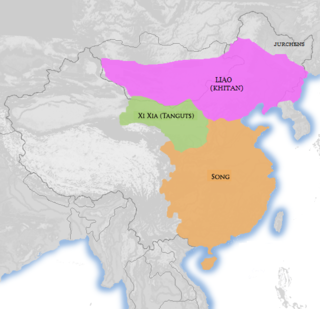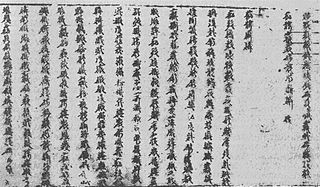Related Research Articles

The Xia dynasty is the first dynasty in traditional Chinese historiography. According to tradition, the Xia dynasty was established by the legendary Yu the Great, after Shun, the last of the Five Emperors, gave the throne to him. In the traditional historiography, the Xia was later succeeded by the Shang dynasty.

The Western Xia or Xi Xia was an empire which existed from 1038 to 1227 in what are now the northwestern Chinese provinces of Ningxia, Gansu, eastern Qinghai, northern Shaanxi, northeastern Xinjiang, southwest Inner Mongolia, and southernmost Outer Mongolia, measuring about 800,000 square kilometres. Its capital was Xingqing, until its destruction by the Mongols in 1227. Most of its written records and architecture were destroyed, so the founders and history of the empire remained obscure until 20th-century research in the West and in China.

The Tangut people were a Tibeto-Burman tribal union that inhabited Western Xia. The group lived under Tuyuhun authority and moved to Northwest China sometime before the 10th century to found the Western Xia or Tangut Empire (1038–1227). They spoke the Tangut language, which was previously believed to be one of the Qiangic languages or Yi languages that belong to the Tibeto-Burman family. Recent phylogenetic and historical linguistic accounts, however, reveal that Tangut belonged to the Gyalrongic languages.
Dynasties in Chinese history, or Chinese dynasties, were hereditary monarchical regimes that ruled over China during much of its history. From the inauguration of dynastic rule by Yu the Great in circa 2070 BC to the abdication of the Xuantong Emperor on 12 February 1912 in the wake of the Xinhai Revolution, China was ruled by a series of successive dynasties. Dynasties of China were not limited to those established by ethnic Han—the dominant Chinese ethnic group—and its predecessor, the Huaxia tribal confederation, but also included those founded by non-Han peoples.

The Drepanidae is a family of moths with about 660 species described worldwide. They are generally divided in three subfamilies which share the same type of hearing organ. Thyatirinae, previously often placed in their own family, bear a superficial resemblance to Noctuidae. Many species in the Drepanid family have a distinctively hook-shaped apex to the forewing, leading to their common name of hook-tips.

Xia Gui, courtesy name Yuyu (禹玉), was a Chinese landscape painter of the Song dynasty. Very little is known about his life, and only a few of his works survive, but he is generally considered one of China's greatest artists. He continued the tradition of Li Tang, further simplifying the earlier Song style to achieve a more immediate, striking effect. Together with Ma Yuan, he founded the so-called Ma-Xia (馬夏) school, one of the most important of the period.

Tangut is an extinct language in the Sino-Tibetan language family. From the 2010s, more and more Tangutologists classify it under the Qiangic language branch, of which, "a close relative of the modern Rgyalrongic languages.

The Erlitou culture was an early Bronze Age urban society and archaeological culture that existed in the Yellow River valley from approximately 1900 to 1500 BC. A 2007 study of radiocarbon dating proposed a narrower date range of 1750 to 1530 BC. The culture was named after the site discovered at Erlitou in Yanshi, Henan. The culture was widely spread throughout Henan and Shanxi and later appeared in Shaanxi and Hubei. Chinese archaeologists generally identify the Erlitou culture as the site of the Xia dynasty, but there is no firm evidence, such as writing, to substantiate such a linkage.
The Red Thread of Fate, also referred to as the Red Thread of Marriage, and other variants, is an East Asian belief originating from Chinese mythology. It is commonly thought of as an invisible red cord around the finger of those that are destined to meet one another in a certain situation as they are "their true love". According to Chinese legend, the deity in charge of "the red thread" is believed to be Yuè Xià Lǎorén (月下老人), often abbreviated to Yuè Lǎo (月老), the old lunar matchmaker god, who is in charge of marriages. In the original Chinese myth, it is tied around both parties' ankles, while in Japanese culture it is bound from a male's thumb to a female's little finger, and in Korean culture, the red thread is thought to be tied around the little finger of both parties. Although in modern times it is common across all three cultures to depict the thread being tied around the fingers, often the little finger. The color red in Chinese culture symbolises happiness and it is also prominently featured during Chinese weddings, such as having both bride and groom wear red throughout the entire procession or at some point during the marriage rituals.

The Tangut script was a logographic writing system, used for writing the extinct Tangut language of the Western Xia dynasty. According to the latest count, 5863 Tangut characters are known, excluding variants. The Tangut characters are similar in appearance to Chinese characters, with the same type of strokes, but the methods of forming characters in the Tangut writing system are significantly different from those of forming Chinese characters. As in Chinese calligraphy, regular, running, cursive and seal scripts were used in Tangut writing.
Xia Xuanze is a former badminton player from China who played singles at the world level from the late 1990s through the first few years of the 21st century. Now he is a singles coach for the national team of China.

Gap junction beta-3 protein (GJB3), also known as connexin 31 (Cx31) — is a protein that in humans is encoded by the GJB3 gene.

Genghis Khan, born Temüjin, was the founder and first Khagan-Emperor of the Mongol Empire, which after his death became the largest contiguous empire in history. He came to power by uniting many of the nomadic tribes of Northeast Asia. After founding the Empire and being proclaimed Genghis Khan, he launched the Mongol invasions that conquered most of Eurasia, reaching as far west as Poland in Europe and the Levant in the Middle East. Campaigns initiated in his lifetime include those against the Qara Khitai, Khwarezmia, and the Western Xia and Jin dynasties, and raids into Medieval Georgia, the Kievan Rus', and Volga Bulgaria. These campaigns were often accompanied by large-scale massacres of the civilian populations, especially in the Western Xia and Khwarazmian-controlled lands. Because of this, he is often depicted in a negative light by historians from these areas. By way of contrast, he was seen as a liberator by the buddhist Uyghur kingdom of Qocho, which willingly left the Qara Khitai empire to become a Mongol vassal. Genghis Khan was also portrayed positively by early Renaissance sources due to the incredible spread of culture, science and technological ideas by the Mongol Empire. By the end of his life, the Mongol Empire occupied a substantial portion of Central Asia and China. Due to his exceptional military successes, Genghis Khan is often considered to be one of the greatest conquerors of all time.

Liu Xia is a Chinese painter, poet, and photographer. Liu Xia was under effective house arrest in China as her husband, Liu Xiaobo, had been awarded the Nobel Peace Prize in 2010. She remained under house arrest until 10 July 2018, when she was allowed to travel to Germany for medical treatment.

Xia Baolong is a Chinese politician. Originally from Tianjin, Xia began his political career in the Communist Youth League. He served as the vice mayor of Tianjin, governor and Communist Party Secretary of Zhejiang province. Since 2018, he has served as a vice chairman of the 13th Chinese People's Political Consultative Conference (CPPCC) and secretary general. He has a doctoral degree in Economics. Xia was appointed director of the Hong Kong and Macau Affairs Office in February 2020.

The Mongol conquest of Western Xia was a series of conflicts between the Mongol Empire and the Tangut Western Xia dynasty. Hoping to gain both plunder and a vassal state, Mongol leader Genghis Khan commanded some initial raids against Western Xia before launching a full-scale invasion in 1209. This marked both the first major invasion conducted by Genghis and the first major Mongol invasion of China.

Kim Jun-su or simply Junsu, also known by the stage name Xia is a South Korean singer, model, dancer and stage actor. He is a member of the Korean pop group and later duo JYJ, and was one of the original members of boy band TVXQ.

The Western Xia was a Tangut-led Chinese dynasty which ruled over what are now the northwestern Chinese provinces of Ningxia, Gansu, eastern Qinghai, northern Shaanxi, northeastern Xinjiang, southwest Inner Mongolia, and southernmost Outer Mongolia from 1032 until 1227 when they were destroyed by the Mongols. The country was established by the Tangut people; likewise its earliest coins were escribed with Tangut characters, while later they would be written in Chinese. Opposed to Song dynasty coins that often read top-bottom-right-left, Western Xia coins exclusively read clockwise. Despite the fact that coins had been cast for over a century and a half, very little were actually produced and coins from Western Xia are a rarity today. Although the Western Xia cast their own coins barter remained widely used.
Changzuiornis is an extinct genus of ornithuromorph bird from the Early Cretaceous of present-day China. It contains a single species, C. ahgmi.
References
- ↑ Beccaloni, G.; Scoble, M.; Kitching, I.; Simonsen, T.; Robinson, G.; Pitkin, B.; Hine, A.; Lyal, C., eds. (2003). "Yucilix xia". The Global Lepidoptera Names Index . Natural History Museum . Retrieved May 15, 2018.